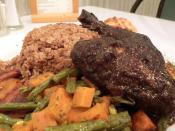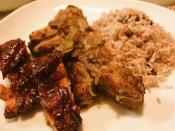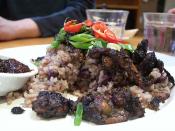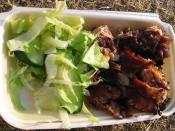Made from local ingredients by a fugitive people, Jamaican Jerk is more than a style of seasoning. Much more than just another way to prepare meat, it is an ever evolving art form.
While it will taste wonderful if cooked on a gas grill or even in an oven, aficionados tell us that it is meant to be barbecued at as low a temperature as possible. They go on to recommend adding pimento (allspice) leaves and branches to the coals for additional flavor.
When Columbus landed on Jamaica in 1494 he found 100,000 Arawaks cultivating taro root, cassava, corn, yams, and peanuts. Guavas, black eyed peas, pineapple and lima beans were growing wild.
They were already cooking their meat in frames fabricated from green sticks called a boucan. Chile was already being used to flavor their meats.
Columbus introduced sugarcane to the island, along with chick peas, coconut, cilantro, eggplant, onions and garlic.
Spain began a settlement in 1509 and remained in control of the island until the British landed in force in 1655. The Spanish were gone by 1660.
During the unrest, Spanish slaves escaped to the Blue Mountains and began their own settlement. Known as Maroons, they were the people who invented Jerk.
The word jerk is said to have originated from an indigenous South American language, and traveled to English via Spanish and, possibly the Arawak language. It does not, as some jerk vendors will tell you, refer to the reaction of your nervous system as you eat this spicy preparation. (Earthlink Explorer 1999) Jerk is a powerful mix fueled by nutmeg, allspice, cinnamon, garlic, scallions or onions, and pepper. The exact proportions and ingredients vary from person to person and one cook claims to use more than 35 ingredients in his sauce.
Among the more popular variations are sweetness in the form of honey and brown sugar, acid in the form of citrus juice and vinegars, herbs such as bayleaf and thyme, and of course, heat. The sources of heat in jerk recipes range from ground cayenne pepper measured by the teaspoon to Scotch Bonnets measured by the gloved fistful. While the nutmeg and allspice do need support from the peppers, it is still best to use common sense.
Available as a seasoning mix, a dry rub, a marinade, a basting sauce, and a serving sauce, jerk is slowly making a niche for itself in the American market.
Suitable for pork, beef, chicken, and fish, jerk has the property of blending with the flavors of the meat. Rather than demote the meat to a minor component, it works supportively to help create a unique, complex flavor.
Not only for cooking meats, jerk is used in some recipes for potato salad, and in black bean soup. It's unique combination of flavors can only gain in popularity as more people get to taste it. Bibliography Earthlink Internet Explorer http://foodwine.com/destinations/jamjerk.html Earthlink Internet Explorer http://www.globalgourmet.com/destinations/caribbean/cariback.html - Mimi Ripee Recipes Earthlink Internet Explorer: http://doacs.state.fl.us/marketing/flckbk/jerkchic.htm http://globalgourmet.com/food/egg/egg0796/jrkburg.html http://sunsite.auc.dk/recipes/english.o0320203 http://www.ichef.com/ichef-recipes/Poultry/232.html Earthlink Netscape: http://www.jamaicans.com/cooking/recipe.htm Earthlink Internet Explorer: http://www.jamaica-villas.com/recipes/jerkseas.htm http://www.wfla.com/mrfood/107.htm http://wmuc.umd.edu/mark/food/jerk.html





